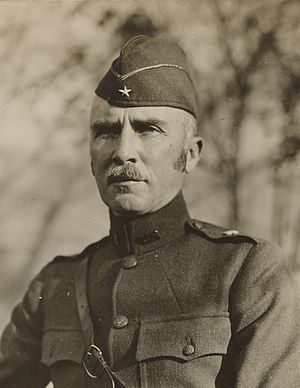Julian Robert Lindsey facts for kids
Quick facts for kids
Julian Lindsey
|
|
|---|---|

Brig. Gen. Julian Lindsey in November 1918
|
|
| Born | March 16, 1871 Irwinton, Georgia |
| Died | June 27, 1948 (aged 77) Washington, D.C. |
| Buried |
West Point Cemetery
|
| Allegiance | |
| Service/ |
|
| Rank | |
| Service number | 0-405 |
| Battles/wars | Boxer Rebellion World War I
|
| Awards | Distinguished Service Medal |
| Children | 1 |
Julian Robert Lindsey (born March 16, 1871 – died June 27, 1948) was an important United States Army officer. He was a cavalry officer, meaning he led soldiers who rode horses. He served in several conflicts, including the Boxer Rebellion in China and the Pancho Villa Expedition. He also commanded a group of soldiers during World War I.
Contents
Early Life and Military Training
Julian Lindsey was born on March 16, 1871, in Irwinton, Georgia. When he was 17 years old, he joined the United States Military Academy. This is a famous school for training army officers.
He graduated four years later and became an officer in the 9th Cavalry. After that, he taught at West Point for four years. Later, he became the Adjutant General of Georgia, which means he was a top military officer for the state.
Early Military Service
Serving in China
In 1900, Lindsey joined the 15th Infantry Regiment. He was an aide to General Adna Chaffee during the China Relief Expedition. This was a mission to help people during the Boxer Rebellion in China.
Back in the U.S.
Lindsey served at Fort Myer until 1912. Then, he returned to West Point to teach again. He even started a Polo team at the Academy in 1916.
He also took part in the Pancho Villa Expedition in 1916. This was a military operation in Mexico. In May 1917, he temporarily led the 11th Cavalry Regiment. After this, he went back to Fort Oglethorpe in Georgia.
World War I Service
Leading Soldiers in Battle
In 1917, Lindsey was sent to Fort Gordon. He became the commander of the 328th Infantry Regiment. He was promoted to Colonel in August 1917.
As part of the American Expeditionary Forces (American soldiers sent to Europe), he took command of the 164th Infantry Brigade. This brigade was part of the 82nd Division. In April 1918, he was promoted to Brigadier General.
Challenges in Command
During the war, Lindsey felt that some of his commanders were not meeting the high standards needed. He asked for two of his regiment commanders and his chief medical officer to be replaced.
Fighting in the Meuse-Argonne Offensive
In October 1918, Lindsey's brigade fought bravely in the Meuse-Argonne Offensive. This was a very important battle in World War I. His soldiers fought in areas around the Aire river, Cornay, and Buzancy.
One of his colonels, Frank D. Ely, had a tough time at Cornay. After capturing the village, he lost it to a German counter-attack. He won it back the next day. After continuous fighting and gas attacks, Ely reported his soldiers were exhausted. He ordered a retreat, and Lindsey removed him from command right there on the battlefield. This decision caused some disagreement with Lindsey's commanding general, Hunter Liggett.
After the War
New Commands
After World War I, Lindsey returned to the rank of Colonel. He held many different jobs. From 1925 to 1928, he commanded the 14th Cavalry Regiment. Then, from 1928 to 1932, he was the Chief of Staff for the 61st Cavalry Division.
In 1932, he was chosen to lead the new 7th Cavalry Brigade (mech). This was a special unit that used new motorized vehicles instead of horses. He led this brigade at Fort Knox as a Brigadier General until May 1934. He was known for his love of golf during this time.
Promotion to Major General
In 1942, a special law was passed by the U.S. Congress. This law allowed World War I generals to be promoted one rank higher on the retired list if they had been recommended for a wartime promotion and had received certain awards. Because Julian Lindsey had received the Army Distinguished Service Medal, he was promoted to major general.
Family and Later Life
Julian Lindsey married Hannah Broster in 1904. Sadly, his wife passed away shortly after their son was born in 1905. After he retired from the army, Lindsey moved to Washington D.C. He lived at the Army and Navy Club. He died from a heart attack on June 27, 1948, at the Walter Reed Hospital.

